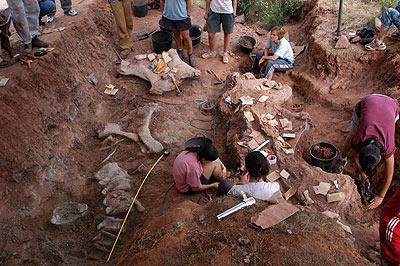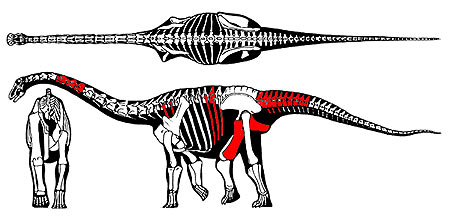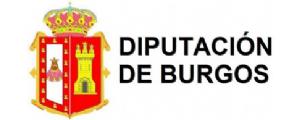History of the Oterillo outcrop
This outcrop was the big surprise of the 2004 excavation campaign. The decision was made to carry out an excavation because of the threat of erosion by torrential streams in heavy rainy seasons.

Un momento de la excavación
© C.A.S.
The Archaeological Association of Salas found abundant bone chips and fragments protruding from the surface of the bank. The surprise started once a larger area of the outcrop was excavated: an accumulation of teeth attributed to carnivorous Theropods dinosaurs were found near a chevron (caudal rib) of a large dinosaur that showed tooth marks made by hunting animals or carrion eaters. Later, excavators found hip bones of a Sauropod dinosaur together with pubis and ischia, ribs, a big dorsal vertebra and up to 8 articulated caudal vertebras, exposed in the way the animal died One of the most interesting aspects is the presence of ossified tendons, some exceeding 1.5 mts long, found for the first time associated with Sauropod dinosaurs. Overall, we have a dinosaur of a big size that could exceed 20 mts long and weight 20 tons; moreover, its bones are almost complete and semi articulated among them, making study of the specimen easy and leading us to hope that a great part of the skeleton remains to be discovered in the next excavations.

Esquema de los huesos recuperados.
© C.A.S.
16 teeth of Theropod dinosaurs of 3 different groups; 4 crocodile teeth. Sauropod pieces: 18 ossified tendons; 11 vertebras; 4 chevrons, 7 ribs, 2 pubises, 2 ischia.
The number of outcrops in Spain where articulated skeletons of Sauropod dinosaurs have been found is limited. Although a single bone can offer worth information to a palaeontologist, abundant remains make it easier to determine that they come from the same animal, to describe and identify the specimen and to theorize about its anatomy and lifestyle. In such circumstances new species may be identified, as happened at Valencia and Teruel. This could come to be the case at Oterillo and also at Los Vallejos, also in the area of Salas de los Infantes (Burgos). The latter is the only known Rebbaquisaurid occurrence in Western Europe.











